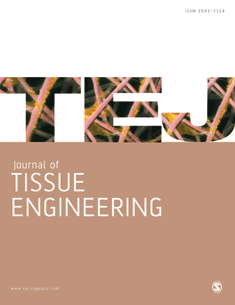
Journal of Tissue Engineering
Scope & Guideline
Connecting Innovators in Tissue Engineering and Biomedical Fields
Introduction
Aims and Scopes
- Tissue Engineering Techniques and Innovations:
The journal covers a wide range of methodologies in tissue engineering, including 3D bioprinting, hydrogel development, and scaffold fabrication, showcasing novel techniques that enhance tissue regeneration. - Stem Cell Research and Applications:
A significant focus is placed on the use of stem cells in tissue engineering, exploring their potential in regeneration, differentiation, and therapeutic applications across various tissue types. - Biomaterials and Extracellular Matrix Engineering:
Research on biomaterials, including their design, modification, and application in tissue scaffolding, is a core area, particularly in relation to their interaction with cellular systems. - Regenerative Medicine and Clinical Applications:
The journal emphasizes translational research that bridges laboratory findings with clinical applications, aiming to improve patient outcomes through advanced tissue repair strategies. - Mechanobiology and Microenvironment Influence:
Studies investigating the effects of mechanical forces and microenvironmental cues on cell behavior and tissue formation are integral to the journal, reflecting the importance of physical factors in tissue engineering.
Trending and Emerging
- 3D Bioprinting and Additive Manufacturing:
The rise of 3D bioprinting technologies is a prominent trend, with increased publications focusing on the development of vascularized tissues and complex structures, showcasing the potential for personalized medicine. - Extracellular Vesicles and Cell Secretomes:
Research on the therapeutic uses of extracellular vesicles and cell secretomes is gaining momentum, emphasizing their roles in cell communication, regeneration, and as delivery vehicles in tissue engineering. - Microenvironmental Engineering and Mechanobiology:
There is a growing focus on understanding and engineering the microenvironment to influence cell behavior and tissue development, particularly through mechanobiology, which explores how physical forces affect cellular processes. - Organ-on-a-Chip Technologies:
Emerging organ-on-a-chip models are being utilized to study disease mechanisms and drug responses, indicating a shift towards more complex and physiologically relevant in vitro systems. - Immunomodulation and Regenerative Strategies:
The intersection of immunology and tissue engineering is increasingly explored, particularly in strategies that aim to modulate immune responses to enhance healing and integration of engineered tissues.
Declining or Waning
- Traditional Tissue Engineering Paradigms:
There is a noticeable decline in papers focused solely on traditional tissue engineering methods without integrating advanced technologies such as bioprinting or nanotechnology, indicating a shift towards more innovative approaches. - Basic In Vitro Models:
Research centered on basic in vitro models without complex tissue architecture or microenvironmental considerations is becoming less prominent, as the field increasingly values more sophisticated and representative models. - Single-Tissue Focus Studies:
There is a waning interest in studies that focus exclusively on single tissue types, as researchers are moving towards more integrative studies that examine interactions across multiple tissue systems and organoids.
Similar Journals

International Journal of Bioprinting
Empowering the bioprinting community with cutting-edge insights.The International Journal of Bioprinting, published by Accscience Publishing, is a pioneering platform dedicated to advancing the field of bioprinting and its applications in biotechnology and manufacturing engineering. Established in 2015, this journal has quickly gained recognition, reflected in its prestigious placements within the Q1 and Q2 quartiles across various categories, including Industrial and Manufacturing Engineering, Biotechnology, and Materials Science. With *Scopus rankings* placing it in the top percentiles of its respective fields, the journal aims to provide researchers, professionals, and students with cutting-edge insights and innovative methodologies that drive the evolution of bioprinting technologies. The International Journal of Bioprinting not only facilitates access to high-quality, peer-reviewed research articles but also supports the rapidly growing community dedicated to the exploration of bioprinting applications, making it an essential resource for those on the forefront of this exciting scientific frontier.
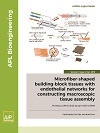
APL Bioengineering
Transforming Ideas into Bioengineering BreakthroughsAPL Bioengineering is a premier open-access journal published by AIP Publishing, dedicated to advancing the field of bioengineering and its interdisciplinary applications. Established in 2017, this journal serves as a vital platform for researchers, professionals, and students interested in the critical intersections of bioengineering, biomaterials, biomedical engineering, and biophysics. With an impressive impact factor and consistent rankings in the Q1 category across multiple domains, including biochemistry and materials science, APL Bioengineering has positioned itself among the top journals in its field. The journal aims to publish innovative original research, comprehensive reviews, and insightful case studies that further the understanding and application of bioengineering principles. Since its inception, APL Bioengineering has fostered a community of thought leaders, providing open access to ensure broad dissemination of knowledge and advancements that underpin the future of biomedical innovation.

Current Stem Cell Research & Therapy
Cultivating Knowledge in Stem Cell ApplicationsCurrent Stem Cell Research & Therapy, published by Bentham Science Publishers Ltd, is a leading journal dedicated to advancing the field of stem cell research. With an ISSN of 1574-888X and an E-ISSN of 2212-3946, this journal has been a valuable resource since its inception in 2006 and continues to broaden its scope through 2024. Recognized in the Q2 quartile for Medicine (miscellaneous) and ranked in the 66th percentile among its peers, the journal plays a crucial role in disseminating high-quality, peer-reviewed research that explores both the therapeutic and biological implications of stem cells. Located in the United Arab Emirates, Current Stem Cell Research & Therapy embraces a global audience of researchers, professionals, and students, providing a vibrant platform for discourse and innovation. While the journal offers subscription-based access, it remains committed to enhancing the scientific community's understanding of stem cell therapy and its applications across various medical fields.
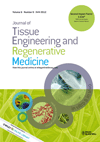
Journal of Tissue Engineering and Regenerative Medicine
Bridging engineering and medicine for transformative health.Journal of Tissue Engineering and Regenerative Medicine, published by WILEY, stands as a pivotal platform in the fields of biomaterials, biomedical engineering, and regenerative medicine. With an ISSN of 1932-6254 and an E-ISSN of 1932-7005, this journal, based in the United Kingdom, has consistently delivered high-quality research since its inception in 2006, converging critical insights through 2024. With an impressive citation profile reflected in its Scopus rankings—specifically a rank of #58 in Medicine and #75 in Biomedical Engineering—the journal is acknowledged for its substantial impact, as demonstrated by its competitive quartile standings in 2023. Notably, it maintains a Q3 ranking in Biomaterials and Q2 in both Biomedical Engineering and Medicine (miscellaneous), showcasing its influence and relevance in the rapidly evolving interplay between engineering and medicine. The journal serves as a vital resource for researchers and practitioners aiming to stay abreast of innovations and breakthroughs in regenerative therapies, tissue scaffolds, and biomaterials. While not an open-access publication, it fosters academic dialogue and knowledge dissemination that is crucial for advancing the field.
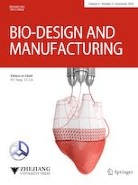
Bio-Design and Manufacturing
Exploring Cutting-Edge Research in Bio-DesignBio-Design and Manufacturing, published by SPRINGER HEIDELBERG, is a pioneering journal that stands at the forefront of innovation in the fields of Biomedical Engineering, Biotechnology, Industrial and Manufacturing Engineering, and Materials Science. With its ISSN 2096-5524 and E-ISSN 2522-8552, this journal has established itself as a leading platform for disseminating cutting-edge research and advancements that merge biological principles with manufacturing processes, emphasizing sustainable and efficient practices. It has garnered recognition in the 2023 category quartiles, boasting a Q1 rank in all its relevant fields, which underscores its significance and impact—evident from its prime Scopus rankings that place it within the top percentiles of numerous engineering and materials science disciplines. Researchers, professionals, and students alike benefit from the wealth of knowledge presented in this journal, making it an essential resource for those seeking to enhance their understanding of bio-design applications and innovation in manufacturing processes.

CELL AND TISSUE BANKING
Pioneering research in cell biology and tissue sustainability.CELL AND TISSUE BANKING, published by Springer, is a prominent journal dedicated to advancing the fields of biomaterials, biomedical engineering, cell biology, and transplantation. With its ISSN 1389-9333 and E-ISSN 1573-6814, the journal plays a crucial role in disseminating high-quality research from its inception in 2000 to its ongoing contributions through 2024. Situated in the Netherlands, it boasts a respectable 2023 impact factor with notable quartile rankings, positioning it within the Q3 category for biomaterials, biomedical engineering, and transplantation, and Q4 for cell biology. Furthermore, its Scopus rankings underscore its relevance and influence, particularly in the fields of medicine and engineering. Although it does not currently offer open access options, the journal remains a vital resource for researchers, professionals, and students alike, fostering innovation and knowledge transfer in the critical areas of cell and tissue sustainability.
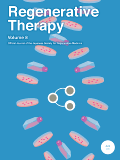
Regenerative Therapy
Unlocking potential in biomaterials and developmental biology.Regenerative Therapy is a premier open-access journal dedicated to advancing the fields of biomaterials, biomedical engineering, and developmental biology. Published by Elsevier in Japan, this journal has been an influential platform since its inception in 2015, contributing significantly to the global discourse on regenerative medicine. With an impressive Q2 ranking in major categories such as Biomaterials and Biomedical Engineering, it is recognized for its quality of research and innovation. Researchers seeking to disseminate their findings or explore cutting-edge developments will find Regenerative Therapy to be invaluable, reflecting current trends and fostering collaborations across interdisciplinary boundaries. The journal offers open access, ensuring that high-quality research is available to a broad audience and enhances the impact of scholarly work in the regenerative medicine community.

Stem Cells and Cloning-Advances and Applications
Pioneering Discoveries in Regenerative MedicineStem Cells and Cloning-Advances and Applications is a leading peer-reviewed journal dedicated to the dynamic fields of stem cell research and cloning technologies. Published by DOVE MEDICAL PRESS LTD in New Zealand since 2008, this Open Access journal ensures that groundbreaking findings are accessible to a global audience. With a focus on innovative applications and advancements in cellular biology, the journal plays a pivotal role in disseminating knowledge within the scientific community. The journal currently holds an impact factor that reflects its influence, with notable rankings in both Cell Biology and Medicine (Miscellaneous), showcasing its interdisciplinary relevance. Researchers, professionals, and students alike benefit from the journal’s wide-ranging contributions, covering critical topics from regenerative medicine to genetic research. With a commitment to fostering collaboration and encouraging discussion in these cutting-edge domains, Stem Cells and Cloning-Advances and Applications continues to be a vital resource for advancing scientific inquiry and application.
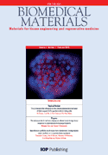
Biomedical Materials
Empowering Research in Biomaterials and Bioengineering.Biomedical Materials, published by IOP Publishing Ltd, is a premier journal dedicated to the rapidly evolving field of biomedical engineering and materials science. With a robust impact factor showcasing its influence, this journal serves as a vital platform for disseminating pioneering research from 2006 to 2024. Covering an array of interdisciplinary topics—ranging from biomaterials to bioengineering and applied chemistry—the journal consistently ranks in the second quartile across multiple categories including Bioengineering (Q2), Biomaterials (Q2), and Biomedical Engineering (Q2) as of 2023. Researchers, professionals, and students alike benefit from its contributions, exploring innovative solutions at the intersection of biology and material science. Although not an Open Access journal, Biomedical Materials remains essential in advancing our understanding and facilitating discussions surrounding state-of-the-art materials that revolutionize medical applications and enhance patient care.

Annual Review of Biomedical Engineering
Advancing the Frontiers of Biomedical InnovationAnnual Review of Biomedical Engineering, published by Annual Reviews, stands as a leading academic journal dedicated to the rapidly evolving field of biomedical engineering. With an impressive impact factor that reflects its high citation rates and rigorous peer-review process, this journal offers critical insights by synthesizing cutting-edge advancements and applications in both biomedical engineering and miscellaneous medicine. The journal, which is available in both print (ISSN: 1523-9829) and electronic formats (E-ISSN: 1545-4274), serves as an essential resource for researchers, professionals, and students aiming to stay abreast of significant developments and emerging trends. As of 2023, it is recognized in the top tier (Q1) for both Biomedical Engineering and Medicine, showcasing its esteemed position within the academic community, reflected in its high Scopus rankings. Spanning from 1999 to 2024, the Annual Review of Biomedical Engineering continues to catalyze interdisciplinary collaboration and innovation at the intersection of engineering and healthcare.